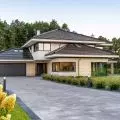Revitalization of parks
Lodz parks seem to function in a similar way. Wide lawns and unmanicured meadows attract an almost infinite number of possibilities and an atmosphere of a certain unconstrainedness. Meanwhile, there is a disturbing tendency to "revitalize" green areas in Lodz.
Why disturbing? Because it is not difficult to get the impression that instead of revitalizing the space, we are dealing with its excessive aestheticization. The recently completed work in the historic Sienkiewicz Park must be improved. What will be the effect of the use of heavy equipment - we will find out in some time. S. Moniuszko Park, located near the Lodz-Fabryczna train station, has been almost covered with granite slabs.
"Revitalized" S. Moniuszko park - a place where granite replaced grass.
Photo: Błażej Ciarkowski
The smooth surface certainly makes it easier for travelers carrying suitcases leaving the nearby station to get around. But is this enough of an argument when the station's surroundings are a granite and concrete desert suffering from a serious shortage of greenery? The only positive change seems to be the construction of a playground adapted for disabled children.
Another of Lodz's parks - Staromiejski and Julianowski - are to be revitalized in the near future. The second case seems particularly interesting, where residents during public consultations strongly protested against the implementation of the proposed project. In their opinion, the interference with the structure of the park (including its wildest part) was too great. Among other things, they objected to the new sidewalks.
The park should remain as natural as possible, with paths that people have trodden for themselves. That's where all the charm is," they said.
One of the undeveloped plots of land in Old Polesie.
Photo: Blazej Ciarkowski
It's interesting that these simple truths can't be seen by many planners....
park on the square
Will new green areas be created in Lodz in the near future? Certainly a lot depends on the city authorities. There are a number of undeveloped plots of land owned (fully or partially) by the municipality within the city center and its environs. They currently serve as wild green spaces, but it might be worthwhile to clean them up a bit and introduce new plantings, for example. This would certainly be a better solution for local residents than selling the plots to developers, who will probably eliminate the last enclaves of biologically active space in the area.
In B. Klepacz Park, users are still warned not to trample the lawns.
Photo: Błażej Ciarkowski
A sign of coming changes seems to be the project to partially transform Freedom Square into a city park. A dozen years ago, the plan was to clean up its space by covering it with stone slabs and implementing pretentious city furniture. Today there is talk of trees and lawns, and designers from the A2P2 studio cite the example of Paris, where it was decided to create "urban forests" in historic squares. I am sincerely rooting for this project, and hope that the result will be an "urban meadow" (or "urban grove"), and not another fenced flower beds in the midst of a stone desert. The familiar slogan "Don't trample the grass!" should be replaced with a new one - "Don't granite the grass!". And let the lawns be used for trampling, sitting, lying, running....












































